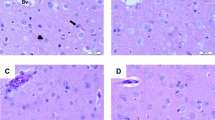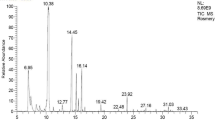Abstract
Hexavalent chromium Cr (VI) causes various toxic and carcinogenic effects. The main carcinogenic effect is observed in the pulmonary system through inhalation route. Reduction of Cr (VI) to Cr (V, IV, and III) reactive intermediates within the cells by intracellular reducing agents such as glutathione is an important event leading to oxidative stress and oxidative DNA damage. This study evaluated the effects of intraperitoneal administration of Cr (VI) and GSH on total oxidant status (TOS), total antioxidant capacity (TAC), oxidative stress index, and oxidative DNA damage by evaluating the level of 8-hydroxy-2́-deoxyguanosine (8-OHdG) in Swiss-Albino mice. Seventy two mice were divided into 6 groups and treated intraperitoneally as follow: control (saline), group GSH (30 mg/kg GSH) groups of Cr-20 (20 mg/kg, K2Cr2O7), Cr-30 (30 mg/kg K2Cr2O7), Cr-20 + GSH (20 mg/kg K2Cr2O7 + 30 mg/kg GSH), Cr-30 + GSH (30 mg/kg K2Cr2O7 + 30 mg/kg GSH). Total oxidant capacities of Cr-20 and Cr-30 were increased compared to control, Cr-20 + GSH, and Cr-30 + GSH. TOS levels in Cr-20 + GSH and Cr-30 + GSH were lower than in Cr-20 and Cr-30. No difference in TAC was observed among the groups. 8-Hydroxy-2́-deoxyguanosine levels were increased in groups Cr-20 and Cr-30 compared with control and groups Cr-20 + GSH and Cr-30 + GSH. No difference was determined in 8-OHdG levels among control, groups GSH, Cr-20 + GSH and Cr-30 + GSH. Results indicate that Cr (VI) given i.p. route causes increased oxidative stress and oxidative DNA damage in the blood of Swiss-Albino mice. Administration of GSH via i.p. route protects from oxidative stress and DNA damage.
Similar content being viewed by others
References
Baruthio F (1992) Toxic effects of chromium and its compounds. Biol Trace Elem Res 32:145–153
Holmes AL, Wise SS, Wise JP (2008) Carcinogenicity of hexavalent chromium. Indian J Med Res 128(4):353–372
Sun H, Brocato J, Costa M (2015) Oral chromium exposure and toxicity. Curr Environ Health Rep 2(3):295–303
Marouani N, Tebourbi O, Hallegue D, Mokni M, Yacoubi MT, Sakly M, Benkhalifa M, Rhouma KB (2015) Mechanisms of chromium hexavalent-induced apoptosis in testis rats. Toxicol Ind Health. doi:10.1177/0748233715600333
Tajima H, Yoshida T, Ohnuma A, Fukuyama T, Hayashi K, Yamaguchi S, Ohtsuka R, Sasaki J, Tomita M, Kojima S, Takahashi N, Kashimoto Y, Kuwahara M, Takeda M, Kosaka T, Nakashima N, Harada T (2010) Pulmonary injury and antioxidant response in mice exposed to arsenate and hexavalent chromium and their combination. Toxicology 267(1–3):118–124
Costa M, Klein CB (2006) Toxicity and carcinogenicity of chromium compounds in humans. Crit Rev Toxicol 36(2):155–163
O'Brien TJ, Ceryak S, Patierno SR (2003) Complexities of chromium carcinogenesis: role of cellular response, repair and recovery mechanisms. Mutat Res-Fund Mol M 533(1–2):3–36
Borneff J, Engelhardt K, Griem W, Kunte H, Reichert J (1968) Carcinogens in water and soil. XXII. Experiment with 3,4-benzopyrene and potassium chromate in mice drink. Arch Hyg Bakteriol 152(1):45–53
Stout MD, Herbert RA, Kissling GE, Collins BJ, Travlos GS, Witt KL, Melnick RL, Abdo KM, Malarkey DE, Hooth MJ (2009) Hexavalent chromium is carcinogenic to F344/N rats and B6C3F1 mice after chronic oral exposure. Environ Health Persp 117(5):716–722
Welling R, Beaumont JJ, Petersen SJ, Alexeeff GV, Steinmaus C (2015) Chromium VI and stomach cancer: a meta-analysis of the current epidemiological evidence. Occup Environ Med 72(2):151–159
Bagchi D, Vuchetich PJ, Bagchi M, Hassoun EA, Tran MX, Tang L, Stohs SJ (1997) Induction of oxidative stress by chronic administration of sodium dichromate [chromium VI] and cadmium chloride [cadmium II] to rats. Free Radical Bio Med 22(3):471–478
Myers CR (2012) The effects of chromium(VI) on the thioredoxin system: implications for redox regulation. Free Radical Bio Med 52(10):2091–2107
Myers JM, Antholine WE, Myers CR (2011) The intracellular redox stress caused by hexavalent chromium is selective for proteins that have key roles in cell survival and thiol redox control. Toxicology 281(1–3):37–47
Nickens KP, Patierno SR, Ceryak S (2010) Chromium genotoxicity: a double-edged sword. Chem Biol Interact 188(2):276–288
Borges KM, Wetterhahn KE (1989) Chromium cross-links glutathione and cysteine to DNA. Carcinogenesis 10(11):2165–2168
Liu X, Lu JF, Liu SJ (1999) Synergistic induction of hydroxyl radical-induced DNA single-strand breaks by chromium(VI) compound and cigarette smoke solution. Mutat Res-Fund Mol M 440(1):109–117
Pattison DI, Davies MJ, Levina A, Dixon NE, Lay PA (2001) Chromium(VI) reduction by catechol(amine)s results in DNA cleavage in vitro: relevance to chromium genotoxicity. Chem Res Toxicol 14(5):500–510
Stearns DM, Courtney KD, Giangrande PH, Phieffer LS, Wetterhahn KE (1994) Chromium(VI) reduction by ascorbate—role of reactive intermediates in DNA-damage in-vitro. Environ Health Persp 102:21–25
Kawanishi S, Inoue S, Sano S (1986) Mechanism of DNA cleavage induced by sodium chromate(VI) in the presence of hydrogen-peroxide. J Biol Chem 261(13):5952–5958
Zhitkovich A, Voitkun V, Costa M (1995) Glutathione and free amino-acids form stable complexes with DNA following exposure of intact mammalian-cells to chromate. Carcinogenesis 16(4):907–913
Kayar A, Dokuzeylul B, Kandemir FM, Kirbas A, Bayrakal A, Or ME (2015) Total oxidant and antioxidant capacities, nitric oxide and malondialdehyde levels in cats seropositive for the feline coronavirus. Vet Med-Czech 60(5):274–281
Ghiselli A, Serafini M, Natella F, Scaccini C (2000) Total antioxidant capacity as a tool to assess redox status: critical view and experimental data. Free Radical Bio Med 29(11):1106–1114
Halliwell B, Cross CE (1994) Oxygen-derived species—their relation to human-disease and environmental-stress. Environ Health Persp 102:5–12
Halliwell B, Gutteridge JMC (1990) The antioxidants of human extracellular fluids. Arch Biochem Biophys 280(1):1–8
Alexander J, Aaseth J (1995) Uptake of chromate in human red-blood-cells and isolated rat-liver cells—the role of the anion carrier. Analyst 120(3):931–933
Tsu TC, Yang JL (1996) Formation of reactive oxygen species and DNA strand breakage during interaction of chromium(III) and hydrogen peroxide in vitro: evidence for a chromium(III)-mediated Fenton-like reaction. Chem Biol Interact 102(3):133–153
Bagchi D, Hassoun EA, Bagchi M, Muldoon DF, Stohs SJ (1995) Oxidative stress-induced by chronic administration of sodium dichromate [Cr(VI)] to rats. Comp Biochem Physiol C Toxicol Pharmacol 110(3):281–287
Wang X, Son YO, Chang QS, Sun LJ, Hitron JA, Budhraja A, Zhang Z, Ke ZJ, Chen F, Luo J, Shi XL (2011) NADPH oxidase activation is required in reactive oxygen species generation and cell transformation induced by hexavalent chromium. Toxicol Sci 123(2):399–410
Garcia-Nino WR, Tapia E, Zazueta C, Zatarain-Barron ZL, Hernandez-Pando R, Vega-Garcia CC, Pedraza-Chaverri J (2013) Curcumin pretreatment prevents potassium dichromate-induced hepatotoxicity, oxidative stress, decreased respiratory complex I activity, and membrane permeability transition pore opening. Evid Based Complement Alternat Med 2013:424692. doi:10.1155/2013/424692
Klaunig JE, Kamendulis LM, Hocevar BA (2010) Oxidative stress and oxidative damage in carcinogenesis. Toxicol Pathol 38(1):96–109
Hojo Y, Satomi Y (1991) In vivo nephrotoxicity induced in mice by chromium(VI). Involvement of glutathione and chromium(V). Biol Trace Elem Res 31(1):21–31
Sugiyama M, Tsuzuki K (1994) Effect of glutathione depletion on formation of paramagnetic chromium in Chinese-hamster V-79 cells. FEBS Lett 341(2–3):273–276
Izzotti A, Bagnasco M, Camoirano A, Orlando M, De Flora S (1998) DNA fragmentation, DNA-protein crosslinks, P-32 postlabeled nucleotidic modifications, and 8-hydroxy-2 '- deoxyguanosine in the lung but not in the liver of rats receiving intratracheal instillations of chromium(VI). Chemoprevention by oral N-acetylcysteine Mutat Res-Fund Mol M 400(1–2):233–244
Zhitkovich A (2005) Importance of chromium-DNA adducts in mutagenicity and toxicity of chromium(VI). Chem Res Toxicol 18(1):3–11
Liebross RH, Wetterhahn KE (1990) In vivo formation of chromium(V) in chick embryo red blood cells. Chem Res Toxicol 3(5):401–403
Shi X, Chiu A, Chen CT, Halliwell B, Castranova V, Vallyathan V (1999) Reduction of chromium (VI) and its relationship to carcinogenesis. J Toxicol Environ Health B Crit Rev 2(1):87–104
Wong V, Armknecht S, Zhitkovich A (2012) Metabolism of Cr(VI) by ascorbate but not glutathione is a low oxidant-generating process. J Trace Elem Med Biol 26(2–3):192–196
Sugiyama M, Tsuzuki K, Ogura R (1991) Effect of ascorbic-acid on DNA damage, cytotoxicity, glutathione-Reductase, and formation of paramagnetic chromium in Chinese-hamster V-79 cells treated with sodium chromate(VI). J Biol Chem 266(6):3383–3386
Author information
Authors and Affiliations
Corresponding author
Ethics declarations
Conflict of Interest
The authors declare that they have no conflict of interests, and that this publication has been approved by all co-authors.
Ethical Approval
All applicable international, national, and/or institutional guidelines for the care and use of animals were followed. All procedures performed in the study involving animals were in accordance with the ethical standards of Kafkas University or practice at which the studies were conducted. All animal testing was conducted after permission for the use of animals was obtained from Kafkas University Local Ethics Committee (permission no. 2012–79).
Rights and permissions
About this article
Cite this article
Kart, A., Koc, E., Dalginli, K.Y. et al. The Therapeutic Role of Glutathione in Oxidative Stress and Oxidative DNA Damage Caused by Hexavalent Chromium. Biol Trace Elem Res 174, 387–391 (2016). https://doi.org/10.1007/s12011-016-0733-0
Received:
Accepted:
Published:
Issue Date:
DOI: https://doi.org/10.1007/s12011-016-0733-0




